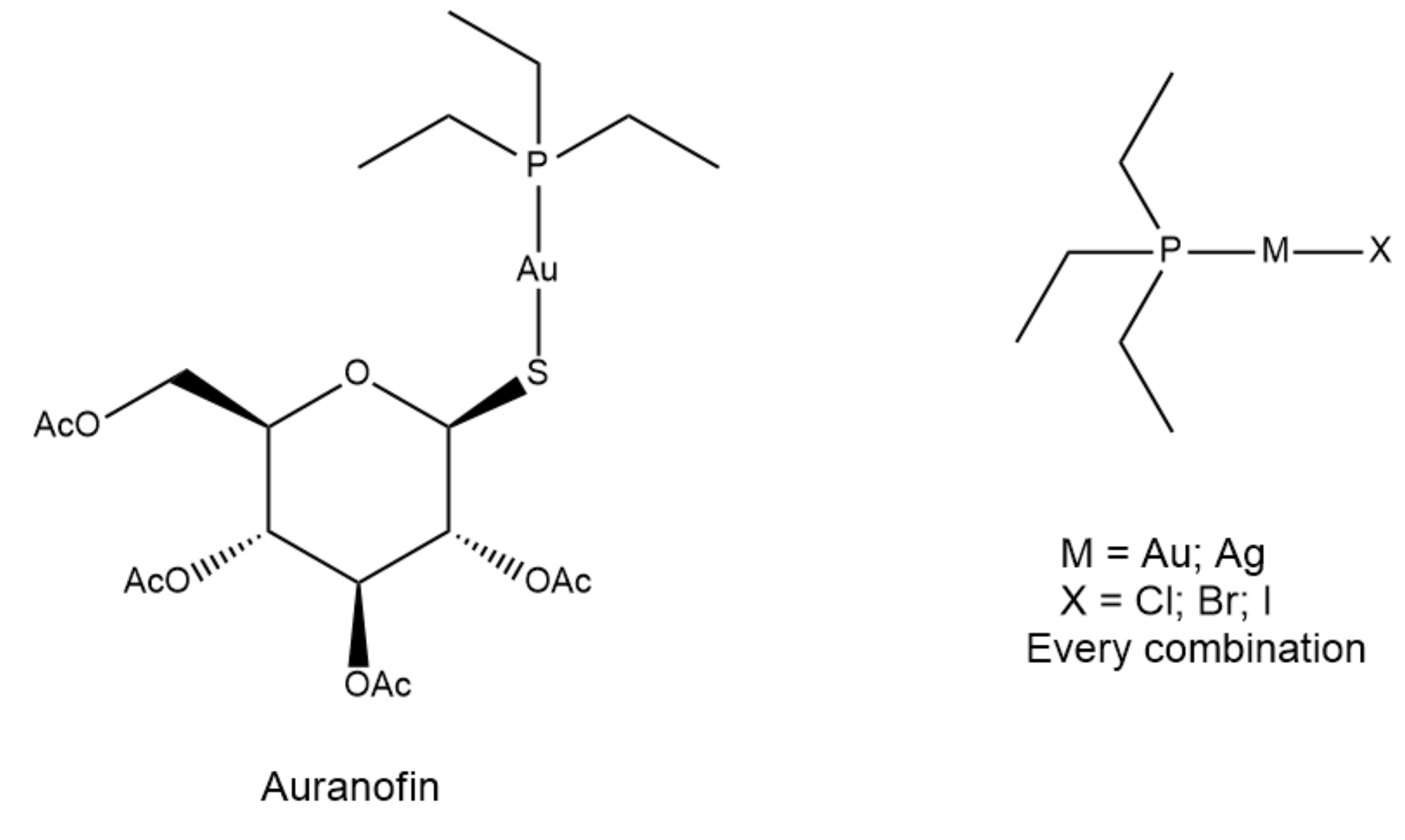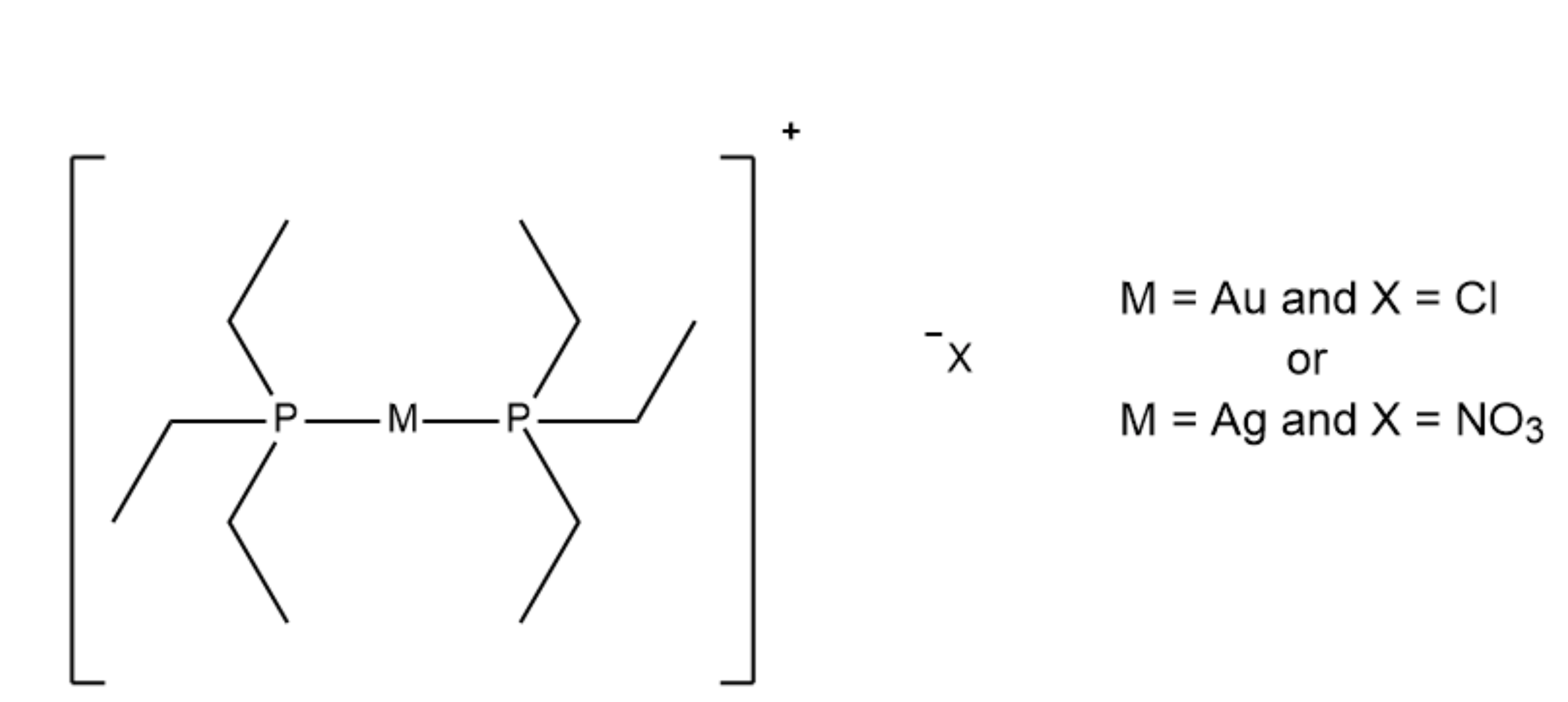Antiproliferative Properties of a Few Auranofin-Related Gold(I) and Silver(I) Complexes in Leukemia Cells and their Interferences with the Ubiquitin Proteasome System
Abstract
1. Introduction
2. Results and Discussion
2.1. In vitro Inhibition of Cancer Cell Growth
2.2. Cross-Reactivity Analysis
3. Materials and Methods
3.1. Cell Culture
3.2. Cytotoxicity Assay
3.3. Enzymatic Assays
3.4. Metal Complexes Preparation
4. Conclusions
Supplementary Materials
Author Contributions
Funding
Acknowledgments
Conflicts of Interest
References
- Simon, T.M.; Kunishima, D.H.; Vibert, G.J.; Lorber, A. Cellular antiproliferative action exerted by auranofin. J. Rheumatol. Suppl. 1979, 5, 91–97. [Google Scholar] [PubMed]
- Kim, N.-H.; Park, H.J.; Oh, M.-K.; Kim, I.-S. Antiproliferative effect of gold(I) compound auranofin through inhibition of STAT3 and telomerase activity in MDA-MB 231 human breast cancer cells. BMB Rep. 2013, 46, 59–64. [Google Scholar] [CrossRef] [PubMed]
- Park, S.-H.G.; Lee, J.G.; Berek, J.S.; Hu, M.C.-T. Auranofin displays anticancer activity against ovarian cancer cells through FOXO3 activation independent of p53. Int. J. Oncol. 2014, 45, 1691–1698. [Google Scholar] [CrossRef] [PubMed]
- Li, H.; Hu, J.; Wu, S.; Wang, L.; Cao, X.; Zhang, X.; Dai, B.; Cao, M.; Shao, R.; Zhang, R.; et al. Auranofin-mediated inhibition of PI3K/AKT/mTOR axis and anticancer activity in non-small cell lung cancer cells. Oncotarget 2015, 7, 3548–3558. [Google Scholar] [CrossRef]
- Onodera, T.; Momose, I.; Kawada, M. Potential Anticancer Activity of Auranofin. Chem. Pharm. Bull. 2019, 67, 186–191. [Google Scholar] [CrossRef]
- Savickienė, J.; Treigytė, G.; Valiuliene, G.; Stirblyte, I.; Navakauskienė, R. Epigenetic and molecular mechanisms underlying the antileukemic activity of the histone deacetylase inhibitor belinostat in human acute promyelocytic leukemia cells. Anti-Cancer Drugs 2014, 25, 938–949. [Google Scholar] [CrossRef]
- Ma, J.; Li, X.; Su, Y.; Zhao, J.; Luedtke, D.A.; Epshteyn, V.; Edwards, H.; Wang, G.; Wang, Z.; Chu, R.; et al. Mechanisms responsible for the synergistic antileukemic interactions between ATR inhibition and cytarabine in acute myeloid leukemia cells. Sci. Rep. 2017, 7, 41950. [Google Scholar] [CrossRef]
- Cloos, J.; Roeten, M.S.; E Franke, N.; Van Meerloo, J.; Zweegman, S.; Kaspers, G.J.; Jansen, G. (Immuno)proteasomes as therapeutic target in acute leukemia. Cancer Metastasis Rev. 2017, 36, 599–615. [Google Scholar] [CrossRef]
- Li, X.; Su, Y.; Madlambayan, G.; Edwards, H.; Polin, L.; Kushner, J.; Dzinic, S.H.; White, K.; Ma, J.; Knight, T.; et al. Antileukemic activity and mechanism of action of the novel PI3K and histone deacetylase dual inhibitor CUDC-907 in acute myeloid leukemia. Haematologica 2019, 104, 2225–2240. [Google Scholar] [CrossRef]
- Dou, Q.P.; Zonder, J.A. Overview of proteasome inhibitor-based anti-cancer therapies: Perspective on bortezomib and second generation proteasome inhibitors versus future generation inhibitors of ubiquitin-proteasome system. Curr. Cancer Drug Targets 2014, 14, 517–536. [Google Scholar] [CrossRef]
- Weissman, A.M.; Shabek, N.; Ciechanover, A. The predator becomes the prey: Regulating the ubiquitin system by ubiquitylation and degradation. Nat. Rev. Mol. Cell Biol. 2011, 12, 605–620. [Google Scholar] [CrossRef] [PubMed]
- Kisselev, A.F.; Van Der Linden, W.A.; Overkleeft, H.S. Proteasome Inhibitors: An Expanding Army Attacking a Unique Target. Chem. Biol. 2012, 19, 99–115. [Google Scholar] [CrossRef] [PubMed]
- Micale, N.; Scarbaci, K.; Troiano, V.; Ettari, R.; Grasso, S.; Zappalà, M. Peptide-Based Proteasome Inhibitors in Anticancer Drug Design. Med. Res. Rev. 2014, 34, 1001–1069. [Google Scholar] [CrossRef] [PubMed]
- Askari, B.; Rrudbari, H.A.; Micale, N.; Schirmeister, T.; Maugeri, A.; Navarra, M. Anticancer study of heterobimetallic platinum(II)-ruthenium(II) and platinum(II)-rhodium(III) complexes with bridging dithiooxamide ligand. J. Organomet. Chem. 2019, 900, 120918. [Google Scholar] [CrossRef]
- Askari, B.; Rrudbari, H.A.; Micale, N.; Schirmeister, T.; Efferth, T.; Seo, E.-J.; Bruno, G.; Schwickert, K. Ruthenium(ii) and palladium(ii) homo- and heterobimetallic complexes: Synthesis, crystal structures, theoretical calculations and biological studies. Dalton Trans. 2019, 48, 15869–15887. [Google Scholar] [CrossRef]
- Shagufta, W.; Ahmad, I. Transition metal complexes as proteasome inhibitors for cancer treatment. Inorg. Chim. Acta 2020, 506, 119521. [Google Scholar] [CrossRef]
- Micale, N.; Schirmeister, T.; Ettari, R.; Cinellu, M.A.; Maiore, L.; Serratrice, M.; Gabbiani, C.; Massai, L.; Messori, L. Selected cytotoxic gold compounds cause significant inhibition of 20S proteasome catalytic activities. J. Inorg. Biochem. 2014, 141, 79–82. [Google Scholar] [CrossRef]
- Marzo, T.; Cirri, D.; Gabbiani, C.; Gamberi, T.; Magherini, F.; Pratesi, A.; Guerri, A.; Biver, T.; Binacchi, F.; Stefanini, M.; et al. Auranofin, Et3PAuCl, and Et3PAuI Are Highly Cytotoxic on Colorectal Cancer Cells: A Chemical and Biological Study. ACS Med. Chem. Lett. 2017, 8, 997–1001. [Google Scholar] [CrossRef]
- Marzo, T.; Cirri, D.; Pollini, S.; Prato, M.; Fallani, S.; Cassetta, M.I.; Novelli, A.; Rossolini, G.M.; Messori, L. Auranofin and its Analogues Show Potent Antimicrobial Activity against Multidrug-Resistant Pathogens: Structure-Activity Relationships. Chem. Med. Chem. 2018, 13, 2448–2454. [Google Scholar] [CrossRef]
- Kadioglu, O.; Cao, J.; Kosyakova, N.; Mrasek, K.; Liehr, T.; Efferth, T. Genomic and transcriptomic profiling of resistant CEM/ADR-5000 and sensitive CCRF-CEM leukaemia cells for unravelling the full complexity of multi-factorial multidrug resistance. Sci. Rep. 2016, 6, 36754. [Google Scholar] [CrossRef]
- Landini, I.; Massai, L.; Cirri, D.; Gamberi, T.; Paoli, P.; Messori, L.; Mini, E.; Nobili, S. Structure-activity relationships in a series of auranofin analogues showing remarkable antiproliferative properties. J. Inorg. Biochem. 2020, 208, 111079. [Google Scholar] [CrossRef] [PubMed]
- Kisselev, A.F.; Callard, A.; Goldberg, A.L.; Foundation, A.S.F.O.T.E. Importance of the Different Proteolytic Sites of the Proteasome and the Efficacy of Inhibitors Varies with the Protein Substrate. J. Biol. Chem. 2006, 281, 8582–8590. [Google Scholar] [CrossRef] [PubMed]
- Sullivan, M.P.; Holtkamp, H.U.; Hartinger, C.G. Antitumor metallodrugs that Target Proteins. In Metallo-drugs: Development and action of anticancer agents, 1st ed.; Sigel, A., Sigel, H., Freisinger, E., Sigel, R.K.O., Eds.; De Gruyter: Berlin, Germany, 2018; Volume 18, pp. 351–386. [Google Scholar]
- Komeda, S.; Casini, A. Next-generation anticancer metallodrugs. Curr. Top. Med. Chem. 2012, 12, 219–235. [Google Scholar] [CrossRef] [PubMed]
- Demo, S.D.; Kirk, C.J.; Aujay, M.A.; Buchholz, T.J.; Dajee, M.; Ho, M.N.; Jiang, J.; Laidig, G.J.; Lewis, E.R.; Parlati, F.; et al. Antitumor Activity of PR-171, a Novel Irreversible Inhibitor of the Proteasome. Cancer Res. 2007, 67, 6383–6391. [Google Scholar] [CrossRef]
- Kimmig, A.; Gekeler, V.; Neumann, M.; Frese, G.; Handgretinger, R.; Kardos, G.; Diddens, H.; Niethammer, D. Susceptibility of multidrug-resistant human leukemia cell lines tohuman interleukin 2-activated killer cells. Cancer Res. 1990, 50, 6793–6799. [Google Scholar]
- Efferth, T.; Konkimalla, V.B.; Wang, Y.-F.; Sauerbrey, A.; Meinhardt, S.; Zintl, F.; Mattern, J.; Volm, M. Prediction of Broad Spectrum Resistance of Tumors towards Anticancer Drugs. Clin. Cancer Res. 2008, 14, 2405–2412. [Google Scholar] [CrossRef]
- O’Brien, J.; Wilson, I.; Orton, T.; Pognan, F. Investigation of the Alamar Blue (resazurin) fluorescent dye for the assessment of mammalian cell cytotoxicity. Eur. J. Inorg. Chem. 2000, 267, 5421–5426. [Google Scholar] [CrossRef]
- Mbaveng, A.T.; Bitchagno, G.T.; Kuete, V.; Tane, P.; Efferth, T. Cytotoxicity of ungeremine towards multi-factorial drug resistant cancer cells and induction of apoptosis, ferroptosis, necroptosis and autophagy. Phytomedicine 2019, 60, 152832. [Google Scholar] [CrossRef]
- Saeed, M.E.; Rahama, M.; Kuete, V.; Dawood, M.; Elbadawi, M.; Sugimoto, Y.; Efferth, T.; Rahama, M. Collateral sensitivity of drug-resistant ABCB5- and mutation-activated EGFR overexpressing cells towards resveratrol due to modulation of SIRT1 expression. Phytomedicine 2019, 59, 152890. [Google Scholar] [CrossRef]
- Saeed, M.E.; Boulos, J.C.; Elhaboub, G.; Rigano, D.; Saab, A.; Loizzo, M.R.; Hassan, L.E.; Sugimoto, Y.; Piacente, S.; Tundis, R.; et al. Cytotoxicity of cucurbitacin E from Citrullus colocynthis against multidrug-resistant cancer cells. Phytomedicine 2019, 62, 152945. [Google Scholar] [CrossRef]
- Mihoubi, M.; Micale, N.; Scala, A.; Jarraya, R.M.; Bouaziz, A.; Schirmeister, T.; Risitano, F.; Piperno, A.; Grassi, G. Synthesis of C3/C1-Substituted Tetrahydroisoquinolines. Molecules 2015, 20, 14902–14914. [Google Scholar] [CrossRef] [PubMed]
- Vicik, R.; Busemann, M.; Gelhaus, C.; Stiefl, N.; Scheiber, J.; Schmitz, W.; Schulz, F.; Mladenovic, M.; Engels, B.; Leippe, M.; et al. Aziridide-Based Inhibitors of Cathepsin L: Synthesis, Inhibition Activity, and Docking Studies. ChemMedChem 2006, 1, 1126–1141. [Google Scholar] [CrossRef] [PubMed]
Sample Availability: Samples of all the compounds are available from the authors. |


| Compound | CCRF-CEM IC50 [µM] | CEM/ADR5000 IC50 [µM] | Degree of Resistance [a] | n |
|---|---|---|---|---|
| auranofin | 0.22 ± 0.08 | 0.28 ± 0.06 | 1.27 | 3 |
| Au(PEt3)Cl | 0.35 ± 0.03 | 0.26 ± 0.04 | 0.74 | 3 |
| Au(PEt3)Br | 0.28 ± 0.06 | 0.27 ± 0.05 | 0.96 | 3 |
| Au(PEt3)I | 0.32 ± 0.07 | 0.28 ± 0.08 | 0.87 | 3 |
| [Au(PEt3)2]Cl | 0.19 ± 0.06 | 0.23 ± 0.09 | 1.21 | 3 |
| Ag(PEt3)Cl | 1.36 ± 0.25 | 2.64 ± 0.48 | 1.94 | 3 |
| Ag(PEt3)Br | 1.50 ± 0.10 | 3.89 ± 0.70 | 2.59 | 3 |
| Ag(PEt3)I | 1.28 ± 0.12 | 1.46 ± 0.15 | 1.14 | 3 |
| [Ag(PEt3)2]NO3 | 1.39 ± 0.04 | 4.24 ± 0.05 | 3.05 | 3 |
| [IC50 Value (µM) or Inhibition (%) at 10 µM] | |||
|---|---|---|---|
| Compound | ChT-L | T-L | PGPH (C-L) |
| auranofin | n.i. a | n.i. | n.i. |
| Au(PEt3)Cl | 2.6 ± 0.3 µM | 1.25 ± 0.05 µM | >10 µM |
| Au(PEt3)Br | 1.4 ± 0.8 µM | 1.26 ± 0.12 µM | >10 µM |
| Au(PEt3)I | 6.1 ± 0.4 µM | 5.80 ± 0.30 µM | >10 µM |
| [Au(PEt3)2]Cl | 21 ± 1.1 % | n.i. | n.i. |
| Ag(PEt3)Cl | 28 ± 0.5 % | 2.20 ± 1.30 µM | n.i. |
| Ag(PEt3)Br | 22 ± 0.4 % | 2.65 ± 0.15 µM | n.i. |
| Ag(PEt3)I | 25 ± 0.2 % | 2.27 ± 0.78 µM | n.i. |
| [Ag(PEt3)2]NO3 | 38 ± 5.0 % | n.i. | n.i. |
| Inhibition (%) at 10 µM | |||
|---|---|---|---|
| Compound | Bovine Pancreatic α-Chymotrypsin | Cat-B | Cat-L |
| auranofin | n.i. a | n.i. | n.i. |
| Au(PEt3)Cl | n.i. | 29 ± 0.2% | n.i. |
| Au(PEt3)Br | n.i. | 31 ± 2.2% | n.i. |
| Au(PEt3)I | n.i. | 29 ± 1.7% | n.i. |
| [Au(PEt3)2]Cl | 20 ± 0.2% | n.i. | n.i. |
| Ag(PEt3)Cl | n.i. | n.i. | n.i. |
| Ag(PEt3)Br | n.i. | n.i. | n.i. |
| Ag(PEt3)I | n.i. | n.i. | n.i. |
| [Ag(PEt3)2]NO3 | n.i. | n.i. | 20 ± 0.4% |
© 2020 by the authors. Licensee MDPI, Basel, Switzerland. This article is an open access article distributed under the terms and conditions of the Creative Commons Attribution (CC BY) license (http://creativecommons.org/licenses/by/4.0/).
Share and Cite
Cirri, D.; Schirmeister, T.; Seo, E.-J.; Efferth, T.; Massai, L.; Messori, L.; Micale, N. Antiproliferative Properties of a Few Auranofin-Related Gold(I) and Silver(I) Complexes in Leukemia Cells and their Interferences with the Ubiquitin Proteasome System. Molecules 2020, 25, 4454. https://doi.org/10.3390/molecules25194454
Cirri D, Schirmeister T, Seo E-J, Efferth T, Massai L, Messori L, Micale N. Antiproliferative Properties of a Few Auranofin-Related Gold(I) and Silver(I) Complexes in Leukemia Cells and their Interferences with the Ubiquitin Proteasome System. Molecules. 2020; 25(19):4454. https://doi.org/10.3390/molecules25194454
Chicago/Turabian StyleCirri, Damiano, Tanja Schirmeister, Ean-Jeong Seo, Thomas Efferth, Lara Massai, Luigi Messori, and Nicola Micale. 2020. "Antiproliferative Properties of a Few Auranofin-Related Gold(I) and Silver(I) Complexes in Leukemia Cells and their Interferences with the Ubiquitin Proteasome System" Molecules 25, no. 19: 4454. https://doi.org/10.3390/molecules25194454
APA StyleCirri, D., Schirmeister, T., Seo, E.-J., Efferth, T., Massai, L., Messori, L., & Micale, N. (2020). Antiproliferative Properties of a Few Auranofin-Related Gold(I) and Silver(I) Complexes in Leukemia Cells and their Interferences with the Ubiquitin Proteasome System. Molecules, 25(19), 4454. https://doi.org/10.3390/molecules25194454










